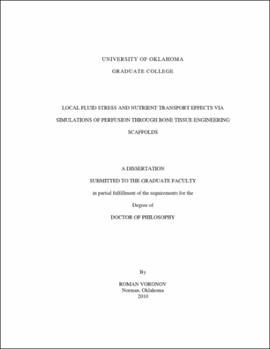| dc.contributor.advisor | Papavassiliou, Dimitrios V||Sikavitsas, Vassilios I | |
| dc.creator | Voronov, Roman | |
| dc.date.accessioned | 2019-04-27T21:35:16Z | |
| dc.date.available | 2019-04-27T21:35:16Z | |
| dc.date.issued | 2010 | |
| dc.identifier | 99317407902042 | |
| dc.identifier.uri | https://hdl.handle.net/11244/319076 | |
| dc.description.abstract | Lattice Boltzmann Method and Lagrangian Scalar Tracking simulations were performed in order to characterize the mechanical and chemical microenvironments within two different types of bone tissue engineering polymer scaffolds: salt leached foam and non-woven fiber mesh. Surface fluid stresses were calculated for triplicates of foam scaffolds prepared with twelve different combinations of porosities and pore sizes. Equations (31) and (32) were developed based on foam scaffolds simulation results that allow for the estimation of average bulk and surface stresses, but require knowledge of the pressure drop across the scaffold. Alternatively, the Wang-Tarbel Equation [see Equation (40)] does not require a pressure drop measurement, but it requires knowledge of Darcy's permeability (which is presented in Table 6 for foam scaffolds with different porosities and average pore sizes). | |
| dc.description.abstract | Non-dimensionalized fluid stress results from the foam scaffolds were analyzed using statistical fits to 65 different distributions and the generalized three point gamma distribution [see Equation (36)] was found to give the best agreement with the simulation results. Furthermore, it was found that the reduced probability density function for the surface stresses does not depend significantly on the scaffold geometry. Using this finding, a generalized three point gamma distribution was derived that can be used to provide an estimate of dimensional surface fluid stresses for highly porous scaffolds within statistically acceptable limits. The estimation procedure requires knowledge of average surface stress and of fitted parameters given in Equation (44), (a simple procedure for obtaining an estimate of average fluid stress based on well established theory is illustrated as a part of this work). Fluid shear results published by other laboratories (obtained for different types of scaffolds using experiment or simulation) fit without statistically significant error to the suggested three point gamma distribution. This provides for a quick and rather simple method for obtaining the surface fluid stress distribution for flows through highly porous media, thereby eliminating the need of detailed simulations or experiments. Furthermore, based on properties of the gamma probability density function, the mode value of surface fluid stress (i.e., the most frequent value) is also available from Equation (45). | |
| dc.description.abstract | In order to characterize nutrient transfer within scaffolds, a novel reactive algorithm was developed as a part of this work for modeling solute transport with first order heterogeneous surface reactions using the Lagrangian scalar tracking methodology. Advantages of this approach are that various Schmidt number solutes and different solute release modes can be simulated with a single solvent flow field and a whole spectrum of solute reactivities can be modeled using just a single set of particles. Preliminary results from this method seem to indicate that the nutrients travel longer distances but survive less time at higher flow rates. At high surface area per total volume ratio of the scaffolds the nutrients are more likely to experience a collision with the scaffold wall, and therefore travel shorter distances and survive for less time. | |
| dc.format.extent | 148 pages | |
| dc.format.medium | application.pdf | |
| dc.language | en_US | |
| dc.relation.requires | Adobe Acrobat Reader | |
| dc.subject | Tissue engineering | |
| dc.subject | Bone regeneration | |
| dc.subject | Biomimetic polymers | |
| dc.title | LOCAL FLUID STRESS AND NUTRIENT TRANSPORT EFFECTS VIA SIMULATIONS OF PERFUSION THROUGH BONE TISSUE ENGINEERING SCAFFOLDS | |
| dc.type | text | |
| dc.type | document | |
| dc.thesis.degree | Ph.D. | |
| ou.group | College of Engineering::School of Chemical, Biological and Materials Engineering | |
